High-Definition Images
Pyrogenic silica is a key constituent of the dry toners used by laser printers and photocopiers. WACKER, together with its distributor Clariant, provides tailor-made solutions.

Good print quality depends on many factors. In the case of photocopiers and laser printers, it largely depends on the toner. This micro-fine powder produces letters and images on paper with razor-sharp definition. The underlying process is electrophotography, in which the dry toner, or rather the toner particles, are charged. For this purpose, a triboelectric effect can be used. This term denotes the charging of two materials when they come into contact with each other and are subsequently separated. The charged particles are transported in electric fields and transferred to the paper.
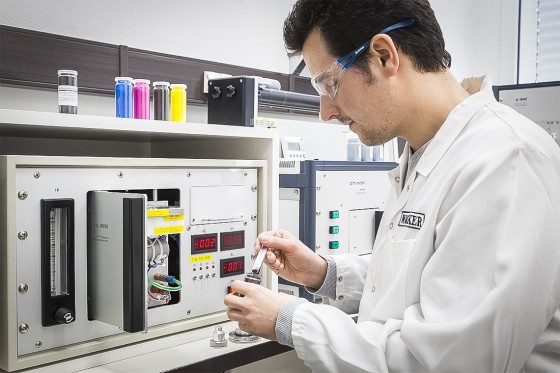
Investigating the chargeability and flowability of a dry toner in the lab.
Continuous improvements of dry toner enable higher print speeds and greater energy efficiency in the printing process – they also ensure flawless print quality. To achieve this, the dry toner needs to be perfectly adapted to the process, since not only the toner, but also the photocopiers and printers are continuously being optimized. Major manufacturers in the key markets of Japan and the USA develop not only toners, but also compatible equipment. By using WACKER’s HDK® pyrogenic silica, manufacturers can selectively adjust essential toner properties such as flowability, triboelectric chargeability and stability – in storage and in use. The highly innovative toner industry can draw on tailor-made products and services provided by WACKER and Clariant.
The success of HDK®, especially in Japan and the USA, is also the result of this long-standing partnership between WACKER and the Swiss chemical group that dates back to the 1980s. In addition to the HDK® produced by WACKER, Clariant also produces and markets other toner additives such as waxes, pigments and charge control agents.
“This extensive application-specific product portfolio and an understanding of the application area as well as the interaction of the individual toner constituents cultivated over many years have contributed enormously to the success of both companies in the toner industry,” said Maria-Anna Biebl, head of WACKER’s HDK® business team. Regional teams at Clariant work closely with Wacker Chemie AG. This ensures that market requirements are identified and innovations are implemented in a targeted manner.
Lab-Scale Production
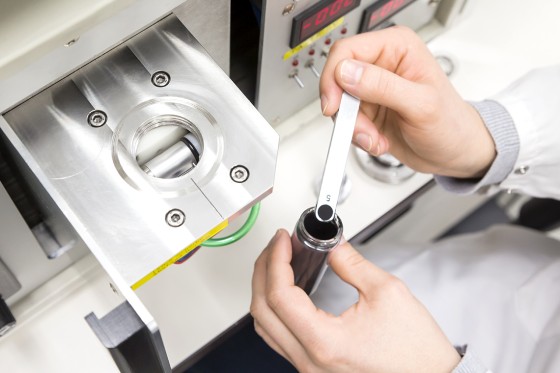
Magnetic dry toner is metered onto a rotating roller, charged and artificially aged to simulate a certain number of copies. The instrumentation determines the charge transferred to the toner.
“Our customers expect supply security and product innovation,” explains Dr. Ingmar Piglosiewicz, the chemist who manages the toner applications lab at WACKER in Burghausen. His team develops tailor-made silica specialties in close collaboration with Clariant and their end customers. The focus is always on customer requirements and long-term practical implementation. In Dr. Piglosiewicz’s experience, it is crucial to be able produce silicas on a laboratory scale.
WACKER technicians also incorporate all the established analytical methods used in the toner industry to align the silica specialties to customers’ requests. “Key properties such as triboelectric chargeability, charge distribution, hydrophobicity and the mechanical strength of dry toners must be positively influenced by the silica products,” stresses Dr. Piglosiewicz. All these measurement parameters are important in electrophotography because the toner particles, which are just a few micrometers in size, must follow their predetermined path on the paper with utmost precision.
Dry toners are essentially composed of a resin, which binds the pigment, waxes and charge control agent. Initially neutral, it becomes triboelectrically charged upon contact with a magnetic powder. Mixing the two powders causes friction and a charge separation. A similar charge phenomenon can be observed when you rub a balloon against a rough surface.
How a Laser Printer Works
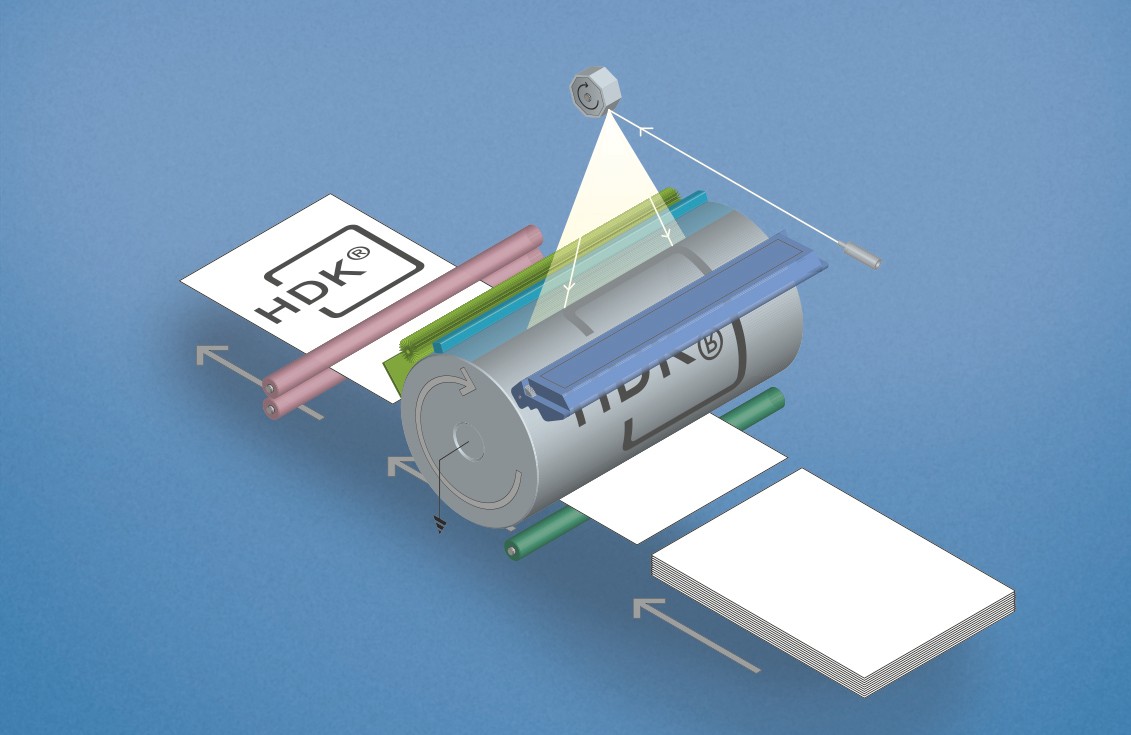
Electrophotography is used in photocopiers and printers: toner particles coated in silica are controlled by electrostatic forces and transferred to the paper.

Laser printer in use: the advantages of this technology include high-speed printing and low costs.
The charged toner particles are first transferred in an electric field to a drum coated with a photo semiconductor. When the photo semiconductor is exposed to light, a latent image, in other words, areas of varying charge, is produced on the drum surface. To transfer the toner particles to the drum, a magnetic brush is used to bring these particles as close as possible to the photo semiconductor. The toner particles of two-component toners are located on the larger particles of the magnetic powder sticking to the brush. The magnetic powder is not transferred. The process can be controlled in such a way that toner particles are conveyed exclusively either to the exposed or to the unexposed regions of the drum. This forms the visible powder image. The dry toner is then transferred to another, more highly charged drum – the transfer drum. The paper is guided between the two rollers such that the dry toner is deposited in a targeted manner, and the powder on the paper is typically fixed at high temperature and pressure, once again using the rollers. The finished printout is thus produced.
Positively and Negatively Charged
Positively and negatively charged dry toners are available on the market. The underlying application process is similar in both cases. The dry toner is transferred to the paper by a non-contact process using electrical fields. The procedure is called non-impact printing.
During use, the dry toner is subject to mechanical stresses, for example, when mixing the toner and the magnetic powder in the charging process. Toners are also handled at different temperatures and air humidities. Throughout the application and under different ambient conditions, the dry toners and toner particles retain their clearly defined form, their outstanding flow properties and their triboelectric characteristics.
“We are able to customize the properties for the application by treating the surface with a wide range of silanes and siloxanes.”
Dr. Ingmar Piglosiewicz, Technical Marketing Manager for HDK®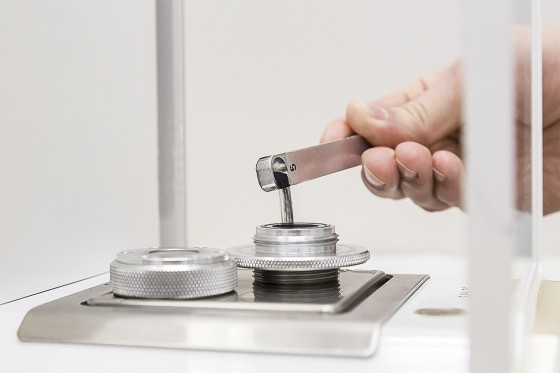
This enables the toner additives to perform a range of functions. Silica as an “external additive” influences several properties, as lab manager Piglosiewicz explains: “hydrophobic silicas significantly reduce the moisture absorption of the toners. This enables the powder to remain free-flowing at any humidity and to retain its triboelectric chargeability. The printing process must function irrespective of the printing duration, temperature and air humidity.”
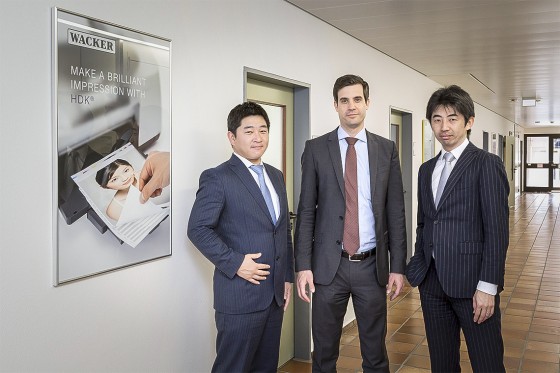
Paying a visit to Burghausen: Takayoshi Miyatani (left; sales director at Clariant Japan) and Daisuke Harada (right; technical sales manager at Clariant Japan), alongside Dr. Ingmar Piglosiewicz (head of WACKER’s technical marketing for HDK®).
Silicas for toner applications have to be well distributed over the surface of the toner particles. On an industrial scale, this is called the additive blending step. This step, which takes place after the raw toner has been produced, is when the silica is admixed. The silicas have to be broken down into smaller entities using as little energy as possible, and homogeneously envelop the toner particles. Only in this way will the desired property profile be achieved. To ensure the process runs smoothly, Piglosiewicz and his team are working on the dispersibility of the silica. It is a measure of how easily the additive can be transferred to the carrier particles. “And we can influence more than the dispersibility,” stresses Piglosiewicz. “We are able to customize the properties for the application by treating the surface with a wide range of silanes and siloxanes. It is also important to select precisely the right particle size and to adjust the particle size distribution.”
“You need to follow the market trend,” says Takayoshi Miyatani. He is the sales director at Clariant Japan and, together with his team, markets WACKER’s pyrogenic silica as well as other toner additives. The Japanese market continually demands new solutions to support manufacturers in meeting requirements for higher print speeds, increased image resolution and even cost and sustainability issues. Producers increasingly rely on toners with low glass transition points and smaller, more defined particle sizes and shapes. These powders can be fixed to the paper using less energy. The process is faster, and increasingly higher image resolutions can be achieved. If the composition of the toner changes, it may also be necessary to adapt the silica product. Piglosiewicz’s team in Burghausen needs to respond accordingly – in close consultation with Clariant and the toner producer.
Establishing Trust
“Regular site visits are extremely important in Japanese business culture,” explains Clariant manager Takayoshi Miyatani. “Face-to-face communication is the only way to build up trust. Only with trust can we jointly address the needs of our established customers and take their requirements into account.” An understanding of the market, Clariant’s presence in the regions, and WACKER’s longstanding experience in the field of silica specialties creates synergies valued by end customers. Or as Takayoshi Miyatani puts it: “Our decades of collaboration and the trust-based relationship with our partner WACKER have proven extremely successful.”
